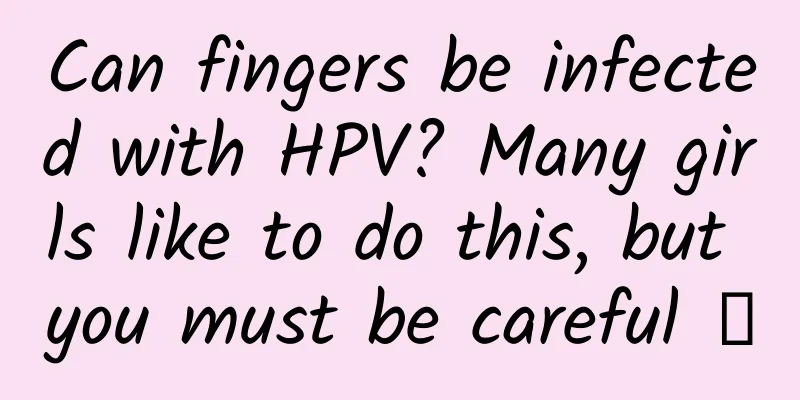Can fingers be infected with HPV? Many girls like to do this, but you must be careful →

|
A while ago, there was a news report about a young lady who liked to do manicures. She found callous-like lumps growing between her nails. The lumps grew bigger and bigger, like cauliflower. After the doctor's diagnosis, it turned out to be skin warts caused by HPV (human papillomavirus) infection . The doctor highly suspected that this was caused by manicure, because the manicurist injured the woman's nails when she was having her manicure at the nail salon. Related Articles This report can't help but make people think of a series of questions, such as whether to do manicures anymore? Why does manicure cause HPV infection? Isn't HPV infection a sexually transmitted disease? How can we avoid HPV infection? If you don't know much about HPV and the basics, these questions can cause panic. In the face of these common doubts, we will now explain them and let everyone know the true face of HPV. Why can manicures cause HPV infection? One thing to clarify is that manicure will not necessarily cause HPV infection . The truth is that improper manicure operation will increase the chance of HPV infection. Therefore, the problem is not the manicure itself, but the improper operation of the manicure . Specifically, during the manicure process, especially when polishing nails or removing "dead skin", if the tools used are not strictly sterilized, or if there are minor breaks in the skin, HPV in the external environment may invade the skin through these wounds . It should be emphasized here that the so-called "dead skin" near the nail is not dead skin in the strict sense, but our normal structure, medically called " cuticle ". Cuticle is a structure connecting the skin and nails, which has an important protective and sealing function, and can effectively prevent various physical, chemical and infectious factors from damaging the nail area. If these dead skin are removed during the manicure process, it is actually hurting the nails . Figure 1. The so-called "dead skin" is actually the nail skin (provided by the author) After an HPV infection, the body's immune system is able to clear the virus in most cases. However, sometimes the virus replicates and multiplies in the surface cells of the skin, eventually forming a rough, wart-like growth that is sometimes more obvious and grows like cauliflower. For this type of wart-like growth, we give it the name " common warts ." If the common warts are around the nails, we can also call them "periungual warts"; if the common warts are under the nails, we call them "subungual warts"; if the common warts are on the soles of the feet, we call them "plantar warts". Figure 2. Periungual warts among skin warts (Source: webpathology.com/) Regardless of where these warts grow, they all have one thing in common: they are unsightly and contagious. They are contagious in two ways: they can spread themselves, causing the warts to grow larger and more numerous; they can also spread to others through contact . Although their overall contagiousness is not strong, these risks cannot be ignored. Therefore, in order to reduce the risk of HPV infection during manicure, it is not to say that manicures cannot be done at all, but you should pay attention to prevention. Here are some useful suggestions for reference: Recommendation 1: Choose disposable nail tools, or ensure that nail tools are strictly disinfected Recommendation 2: During the operation, manicurists and customers should avoid direct skin contact as much as possible Tip 3: When doing manicure, do not damage the surrounding skin, and do not remove the "dead skin" such as the cuticle. Tip 4: Don’t do manicures too often, and stop when you have enough. These conditions may also cause skin infection with HPV By the way, in addition to manicures, there are some personal habits or life events that can increase the risk of HPV infection on the skin. For example, public facilities such as public swimming pools and water parks. This is because if there happens to be a minor wound on the skin and it comes into contact with objects or environments contaminated by the virus (for example, walking barefoot in a public swimming pool), there is a certain probability of infection. However, the chance of this infection is not very high, and for this reason, most people do not take it seriously. Another example is sharing personal items, such as towels, razors, footbaths, and nail clippers. Direct contact with infected personal items can also allow HPV to enter the skin. Especially in a humid environment, the virus is relatively easy to spread. Even smoking and drinking can increase the risk of infection. The reason for this is that a study in India found that people who smoke or drink have a higher risk of HPV infection than the general population. The reason for this association may be that smoking and drinking can indirectly increase the risk of HPV infection by affecting the immune system or increasing skin damage. Is HPV infection equivalent to a sexually transmitted disease? Many people mistakenly believe that HPV infection is equivalent to a sexually transmitted disease, and therefore panic. In fact, there is no need to worry. In fact, there are many subtypes of HPV, as many as 200. Some of these virus subtypes are easily transmitted through sexual contact, while others are easily transmitted through skin contact. The common warts mentioned above are caused by HPV infection which is transmitted through non-sexual contact. Therefore, HPV infection is far from being equated with sexually transmitted diseases . Including common warts, flat warts, filiform warts, digital warts and other skin warts are not sexually transmitted diseases (or STDs). HPV infection, which is truly a sexually transmitted disease, is called genital warts , and its other name is anogenital warts . Genital warts are less common than various skin warts and mainly occur in areas of sexual contact, especially private parts. Below, we have used a table to sort out the differences between skin warts and genital warts. It is very important to understand the difference between the two to avoid misunderstandings and unnecessary panic. Table 1. Skin warts vs condyloma acuminatum How to prevent HPV infection? If you don't want to get HPV infection such as genital warts, what you can do is to keep yourself clean and avoid bad sexual behavior (this aspect is not the focus of this article, so we won't go into details). If you don't want to get infected with various skin warts, you should maintain good hygiene habits. To elaborate, these details can play a good preventive effect: Avoid touching other people’s warts. Protect your skin and try to avoid various skin injuries; Pay attention to hand hygiene and learn the 7-step hand washing method; Do not share personal items with others; · Pay attention to cleaning and disinfection when using shared items, such as nail tools; Take good protection in public places, such as not walking barefoot in swimming pools ; It would be better if you can quit smoking and drinking. In addition, I believe many people have heard of HPV vaccines. But it should be noted that HPV vaccines are mainly used to prevent individual high-risk HPV infections, and can then play a preventive role in some cervical cancers and genital warts . Unfortunately, the effectiveness of existing vaccines in preventing skin warts is not very clear, and there is only a small amount of evidence that vaccines may have a certain preventive effect on certain types of skin warts. If you get the HPV vaccine for the prevention of cervical cancer, it is possible (note, only possible) that the vaccine will have some effect in preventing skin warts, just as icing on the cake. References [1] Nunes RAL, Morale MG, Silva GÁF, et al. Innate immunity and HPV: friends or foes. Clinics (Sao Paulo). 2018; 73(suppl 1): e549s. [2] Martin WA. HPV vaccine may have role in wart treatment. BMJ. 2011; 343: d4351. [3] Petca A, Borislavschi A, Zvanca ME, et al. Non-sexual HPV transmission and role of vaccination for a better future (Review). Exp Ther Med. 2020; 20(6): 186. [4] UpToDate. Cutaneous warts (common, plantar and flat warts). https://www.uptodate.com/contents/en/cutaneous-warts-common-plantar-and-flat-warts [5] Burli A, Hancock S, Zhao YT, et al. HPV vaccination status and resolution of warts in pediatric patients. Indian J Dermatol. 2021; 66(6): 604-608. Planning and production Author: Tang Jiaoqing, MD, attending physician of dermatology Review | Feng Jun, deputy chief physician of the Dermatology Department of Sinopharm Tongmei General Hospital Planning丨He Tong Editor: He Tong Proofread by Xu Lailinlin The cover image and the images in this article are from the copyright library Reprinting may lead to copyright disputes |
<<: Science Magazine: Invisibility, will this scientific fantasy become reality?
>>: What imprints of traditional culture are there in aerospace engineering?
Recommend
Zhihu advertising, Zhihu advertising forms
Zhihu community is the largest knowledge platform...
Why doesn’t Pinduoduo have a shopping cart?
In October 2019, Pinduoduo's market value sur...
Don’t rush to eat snacks after unpacking the package! It may cause this disease!
There’s no room left, come and get it! Don't ...
Tiemenguan SEO training: What is the value of the H1 tag to SEO? How to set up H1
As we all know, the H1 tag is one of the most imp...
Channel promotion: How to choose high-quality and suitable APP promotion channels
In the operation and promotion of APP, learning t...
How to choose safer soy sauce? What are the cognitive misunderstandings? Learn more in one article →
Recently, reports that cadmium and arsenic were d...
How much does it cost to join the Changge Parent-Child Mini Program? Changge Parent-Child Mini Program Franchise Price Inquiry
Why join the WeChat Mini Program Development Comp...
10 basic skills necessary for operating Douyin
Douyin became a huge hit like a bolt from the blu...
A spider "resurrected from the dead" and turned into a claw machine in seconds? This study is a bit "weird and interesting"
A dead spider slowly descends, and then, suddenly...
In-depth cooperation between hardware and content: ZIVOO and Mango TV open a new chapter in OTT ecology
With the advent of the intelligent era, hardware ...
How to do content operation well depends on these 8 details!
This article mainly shares the author’s valuable,...
"China's Sky Eye" has made new discoveries!
The "China Sky Eye" has made new discov...
Count down 8 types of operation tools you must learn
As the saying goes, if you want to do your work w...
Review of B-side operational activities: Find the purpose and users
The author reviewed a B-side operation activity a...
Introduction to the advantages of 360 search promotion display advertising system!
What is the display advertising system? Display a...









